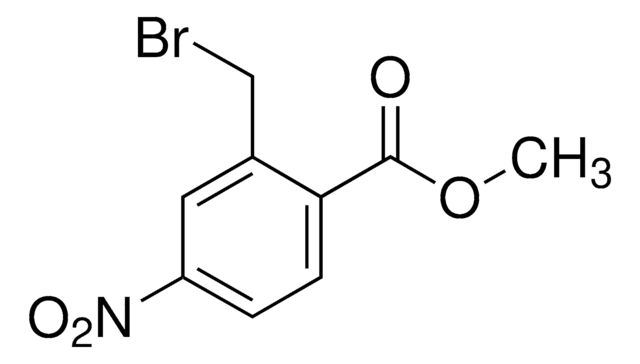162906
2-Hydroxy-5-nitrobenzyl bromide
90%
Sinonimo/i:
α-Bromo-4-nitro-o-cresol, 2-Bromomethyl-4-nitrophenol, Koshland I, Koshland’s Reagent I
About This Item
Prodotti consigliati
Saggio
90%
Forma fisica
solid
Punto di fusione
144-149 °C (lit.)
Solubilità
chloroform: soluble 25 mg/mL, clear, yellow
Temperatura di conservazione
2-8°C
Stringa SMILE
Oc1ccc(cc1CBr)[N+]([O-])=O
InChI
1S/C7H6BrNO3/c8-4-5-3-6(9(11)12)1-2-7(5)10/h1-3,10H,4H2
KFDPCYZHENQOBV-UHFFFAOYSA-N
Cerchi prodotti simili? Visita Guida al confronto tra prodotti
Descrizione generale
Applicazioni
Altre note
Avvertenze
Danger
Indicazioni di pericolo
Classi di pericolo
Skin Corr. 1B
Codice della classe di stoccaggio
8A - Combustible corrosive hazardous materials
Classe di pericolosità dell'acqua (WGK)
WGK 3
Punto d’infiammabilità (°F)
Not applicable
Punto d’infiammabilità (°C)
Not applicable
Dispositivi di protezione individuale
Eyeshields, Faceshields, Gloves, type P3 (EN 143) respirator cartridges
Certificati d'analisi (COA)
Cerca il Certificati d'analisi (COA) digitando il numero di lotto/batch corrispondente. I numeri di lotto o di batch sono stampati sull'etichetta dei prodotti dopo la parola ‘Lotto’ o ‘Batch’.
Possiedi già questo prodotto?
I documenti relativi ai prodotti acquistati recentemente sono disponibili nell’Archivio dei documenti.
Il team dei nostri ricercatori vanta grande esperienza in tutte le aree della ricerca quali Life Science, scienza dei materiali, sintesi chimica, cromatografia, discipline analitiche, ecc..
Contatta l'Assistenza Tecnica.









